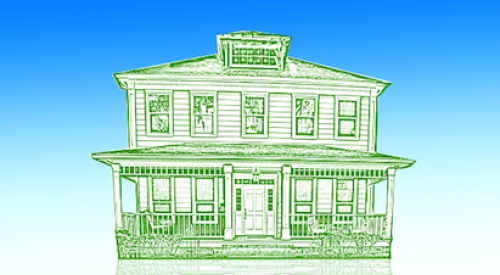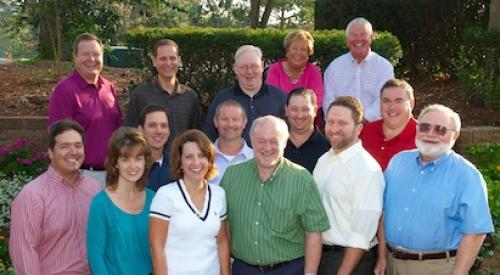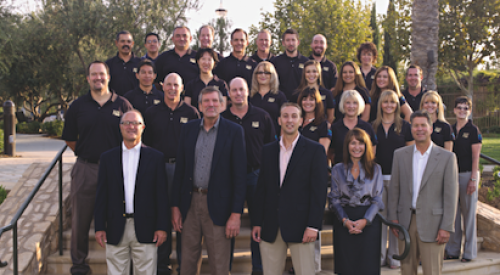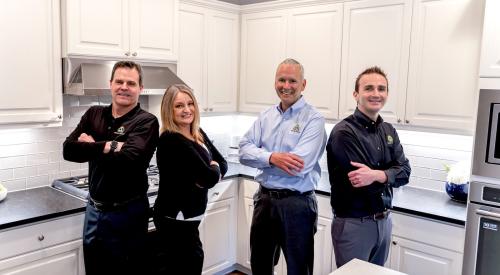| Leadership: Palm Harbor’s management team includes (front row from left) Chuck Rogers, Benny Nelson, Angela Dillow, Jody Jenkins, Bill Van Stronder, (second row from left) Mike Draper, Harry Torgersen, Ed Lehmann, Gary Legg, (back row from left) Tim Schaefen, Mike Wnek and Rick Salica.
|
A decade ago, on the strength of huge performance improvements in American manufacturing giants such as Motorola, Ford and General Electric, home builders across the country began to embrace the statistical quality-control methods of total quality management gurus such as Deming and Crosby. For many builders, however, this is a tough row to hoe. After all, the vast majority of a builder’s actual production work is subcontracted, performed by workers beyond direct control and outside the corporate culture of the builder. And widely scattered construction sites make eliminating the variables that compromise quality maddeningly difficult. But none of these limitations seems to affect manufactured housing, in which most work is done in the same kind of highly controlled, assembly line environments as those of the acknowledged leaders in TQM.
However, just as a few firms stand out in other industries, a small number stand out in home manufacturing, especially today, with the industry now in retreat, plagued by declining sales, overproduction, plant closings and the potential for multiple business failures in the near future. Times such as these test the true mettle of a company.
National Housing Quality Award judges examined the inner workings of a strong manufactured housing competitor when Dallas-based Palm Harbor Homes entered its Florida division in the competition. The firm came away with a Gold Award.
Surprisingly, Palm Harbor’s success springs, in part, from recognition that home manufacturers are really not so different from site builders. The firm pays a lot of attention to what happens to the home (and to customers) on site, away from the factory.
Vertical Integration
Founded in Florida in 1977 by chairman Lee Posey, Palm Harbor is entrenched in the second tier of the top 10 producers in the home manufacturing sector and operates in its most interesting niche.
"Palm Harbor is the Toll Brothers of the manufactured housing industry," says Wall Street analyst Barbara Allen of Arnhold and Bleichroeder. "They cater to higher-income buyers with customized, upscale homes and stay away from the riskier entry-level segment of the market. And they are systematically moving toward full vertical integration in a sector that disdains such control.
| Palm Harbor has a company-owned "superstore" retail location next to its Florida plants.
|
"But it’s a strategy that serves Palm Harbor well. They sell quality, value and service, not price. And in an industry that has been much more volatile over the past two decades than site-built housing, Palm Harbor’s conservative, internally driven growth allows the company to maintain profitability in bad times."
Palm Harbor has 15 manufacturing plants scattered across the country, and sells homes through 200 independent retail sales centers and 133 company-owned "superstores." In the fiscal year ended March 31, 2000, the firm sold 14,301 homes for $777.5 million in revenue (up 2.1% from fiscal 1999). And while net income declined from $40.2 million to $38.6 million because of the competitive carnage in the industry, there’s no blood on this balance sheet.
Almost exactly 80% of production is in multisection, upscale units averaging $58,000 in price (excluding land). Some are as large as 4,000 square feet. In fiscal 2000, the company sold 11,078 homes through its "superstore" outlets and only 3,223 through independent retailers. Executives now promise that the day will come when Palm Harbor sells only through its retail outlets, while Standard Casualty, a retail insurance subsidiary, and Country Place Mortgage, a financing arm, round out the vertical integration.
‘Cadillac’ Product
A typical Palm Harbor home has two to five bedrooms, a living room, a family room, a dining room, a kitchen, two or three bathrooms, and amenities such as central heating and air conditioning, a range, a refrigerator, carpeting and drapes, and tiled kitchen floors. Options include dishwashers, clothes washers and dryers, specialty cabinetry, furniture packages, and a wide range of moldings and finishes. The firm also offers many options previously associated only with site-built housing, such as stone fireplaces, skylights, vaulted ceilings and whirlpool baths. Roofs can even be hinged to ship flat and then tilt up on site for the higher-pitched style of a site-built home.
| The manufacturing plants are open to the public. Palm Harbor conducts regular tours to show home buyers its state-of-the-art quality-control methods and production facilities.
|
Nearly 90% of Palm Harbor’s homes are now customized to some degree, and 10% are pure custom. The efficiency of this customization process is maximized in the firm’s superstores. Palm Harbor opened 13 in fiscal 2000 and plans to add 15 to 20 retail outlets in fiscal 2001.
"Our buyers can order just about anything they want that fits within the confines of what we can ship down the road," Florida division president Mike Draper says. "We’ve had people come in with a sketch of what they want on a Burger King napkin. We have a team of engineers that sit down with customers on the computer and work out a floor plan.
"We do hardly any spec building," says Draper. "Eighty percent of what we build is pre-sold, the rest models for our various sales centers."
Site builders might be surprised by the high level of specs on Palm Harbor Homes, including 2 X 8 floor joists (16 inches on center); 2 X 6 exterior walls (16 inches on center); 3/4-inch tongue-and-groove plywood floors (nailed, not stapled); insulation to R-30 in the roof, R-19 in walls, and R-11 in floors; double-paned, insulated glass windows; and 6-inch-deep marble window sills.
Field Completions
Customer focus and quality control drive the vertical integration approach: "We studied our processes 10 years ago and decided we had to control the sales process to better match product to buyer desires and expectations," says CEO Larry Keener, who also decided Palm Harbor needed to get into field completions of its houses "to assure the ultimate quality of our product to customers on site."
Says Keener: "We learned that most of the setup contractors employed by our retailers do a pretty good job on the ‘rough set,’ which is putting the sections together on site, getting them level and making sure they are structurally anchored and ‘weathered in.’
"But they were doing a very poor job on interior finishing. And that’s the stuff our customers sit and look at every day. We now take the position that we have to be responsible for any discrepancy between our finished product and our model homes.
"There’s a bias toward ‘build it, ship it and forget it’ in this industry," says Keener. "It took us almost four years to get field completions up and running in Florida, and another four years to bring the rest of the company on line. We now have 450 trucks out in the field, with factory-trained crews doing all of our final trim and detailing work. We call them ‘Gold Key Care’ technicians."
Quality Culture and Training
| A typical Palm Harbor home has two to five bedrooms, a living room, a family room, a dining room, a kitchen, two or three bathrooms, and amenities such as central heating and air conditioning, carpeting, drapes and tiled kitchen floors.
|
However, vertical integration is only part of Palm Harbor’s quality story. Having the whole process under one company, from sale to production to delivery to service, does no good unless employees have the will to make it work on behalf of customers and the trained ability to fill their roles in the process. Quality culture is the beating heart of Palm Harbor Homes.
It’s really no surprise that the Florida division was the one to enter the NHQ competition. Palm Harbor’s TQM initiative began in the two plants located side by side in Plant City, Fla., in 1988.
The Florida division now builds 1,400 units a year, for $60 million in revenue. It has 435 full-time employees. A huge superstore with dozens of models on display surrounds the two plants.
Keener says Florida remains the quality leader, but the gap in measures such as customer satisfaction index (CSI) and employee satisfaction index (ESI) among Palm Harbor divisions is now less than 10% across the company. Significantly, Palm Harbor places virtually equal weight on those two measures.
The firm’s mission statement reads: "To build homes of such high value and quality that our customers will feel compelled to recommend our homes to their family and friends. To make Palm Harbor Homes a great place to work and help our associates make this the best job they have ever had."
Ed Caldeira, manager of quality programs for the NAHB Research Center, facilitated the NHQ judging process. He says the most striking aspect of Palm Harbor is the way the company’s leaders have changed the role of management from directing operations to facilitating teams. "It is teams that manage all the critical operations," he says. "This enhances both employee satisfaction and continuous improvement. It’s really unleashed this whole company."
The emphasis on employee satisfaction is key. "If we want to keep improving our product and our levels of customer satisfaction, we need every associate to buy into those goals," says manufacturing production manager Benny Nelson, who leads one of the Florida plants. "Everyone has to be working toward the common purpose of eliminating nonconformances. We will not knowingly pass a defect on to any customer, either internal or external."
Education and training in Palm Harbor’s "Quality College" build the strength of individuals and teams. After hiring, every associate has two eight-hour courses of classroom training in the firm’s "quality education system" (QES).
"QES instills a zero-defect attitude so that every associate wants to do the job right the first time," Nelson says. "Each associate is trained thoroughly in his or her individual duties and encouraged to cross-train not only within the department but across departmental boundaries. There’s virtually no limit to the training we provide, either here or through tuition reimbursements for off-site classes. All of the training is recorded in a skills matrix for each individual that we consult to meet personnel needs as they arise. It’s a record that allows the associate and the company to plan career paths."
Draper says, "We are constantly challenging our associates to improve, and we reward their efforts by promoting primarily from within. We try to keep everyone focused on a goal to sustain our customer satisfaction index at 95% or higher. And we strive for an average annual turnover percentage at or below 30%. By focusing on those two items, market share and profits come as well."
Empowered Teams
A master quality improvement team (QIT) includes senior managers and line associates. It acts as the organizational body governing teams for quality improvement (TQI) that represent each department within the company. Corrective action teams (CAT) also are organized across departmental lines for trouble-shooting and specific problem solving. Every associate belongs to at least one team.
"Each team must turn in one opportunity for improvement each month for every three members," Nelson says. "That would be one OFI if the team has three members, two if it has six members, and so on."
Every associate has a portion of compensation tied to generation of OFIs and another portion determined by the company’s customer satisfaction index. "We’ve adapted the Phillip Crosby quality improvement method to our industry," Nelson says. "The teams meet each week to discuss and implement quality improvements in their work areas."
All of the teams are empowered to self-inspect their production. A "production traveler" form goes with each house from workstation to workstation. It is initialed by the associates as they check and verify that work is done and correct. Each team also charts its rework as it occurs. As team-established rework goals are met, each team also receives additional compensation in the form of gain-sharing points toward year-end bonuses.
Partnering With Suppliers
Another annual event in the Florida division is the "Cost Walk," which involves not only employees from all parts of the organization but also representatives of supply firms. It occurs on a Saturday. The group meets, breaks into teams, and conducts a thorough investigation of both plants and the adjacent superstore and model center to search for new ideas for cost reduction through process improvement.
"Our vendors are the key element of this event," Draper says. "This year we’ve invited them to make formal presentations to the full group on new materials and methods. Our most recent Cost Walk generated over 500 ideas. Many of them were implemented, and we documented savings of over $150,000 a year."
Palm Harbor holds its suppliers to very high standards, including regular quarterly evaluations of products and materials by outside salespeople, inside sales, and customer service and warranty personnel. Product quality and warranty service are evaluated along with shipping and delivery capability, and invoicing and credit systems. Each category has at least four line items that are graded. Points total a possible score of 100, and vendors must maintain an average of 90 to stay in good standing.
Measurements and Results
| "Gold Key Care" technicians, trained at the factory, handle the final detailing and interior trim work on site to ensure that final product matches model home quality.
|
Palm Harbor stays in constant communication with customers to stay ahead of issues that could compromise the critical customer satisfaction index. Gold Key Care technicians provide each customer with a 200-item, room-by-room inspection checklist and then go over each item before asking for a signature that affirms the home is defect-free before the customer moves in. If there are issues, they are fixed on the spot. "We’ve found that the single most important factor for achieving high levels of customer satisfaction is a defect-free house at move-in," Draper says.
After the customer has been in the house for two months, a "customer satisfaction administrator" calls to make sure no issues exist. At five months, a senior manager calls to see if the customer remains happy and if any issues have cropped up.
Finally, Palm Harbor retains an independent survey firm, Decision Analysts, to conduct a formal telephone survey at six months after move-in. During the survey, customers are asked if they would recommend Palm Harbor Homes and the retail location where they bought the home to family and friends. The "would recommend" question is the basis of the consumer satisfaction index.
The Florida division CSI was 89.65% for fiscal 1998, 91.4% in 1999 and 92.7% in 2000.
Another part of the survey allows customers to identify attributes they consider important to a "yes" answer on the "would recommend" question. Attributes such as "response time" and "completeness of repairs" are tracked by the warranty service department, and a portion of the Gold Key Care technicians’ bonus plans is tied to this measure. Customer ratings on sales and installation processes are also tracked and shared with the retailers involved.
To show that Palm Harbor takes customer satisfaction personally, customers are provided with a "direct line" postcard on which they can provide feedback that goes directly to the plant manager. He responds personally with a letter addressing the issues brought to his attention.
Another important report is the final trim-out (FTO), which feeds information back to the plant on what difficulties Gold Key Care technicians might encounter in the field to satisfy a customer. Plant staff uses the report to revise work processes if a change holds the promise of correcting recurring problems in the field. Also, field technicians are required to spend one week a year at one of the factories, working directly with production personnel on issues that have come up in the field.
Palm Harbor also tracks trends of customer needs and expectations by surveying the 12,000 to 13,000 traffic units per year who visit the Plant City superstore and model center. The survey identifies customer impressions of the various homes on display and solicits ideas for goods or services not currently in the Palm Harbor offering. Each visitor is asked to fill out a survey form before leaving.
Like all practitioners of the Phillip Crosby quality control methodology, Palm Harbor calculates the "cost of quality," a measure of all costs associated with not doing work right the first time. This includes such elements as inspection wages, warranty costs, workers’ compensation, sales deductions and bad debt. For fiscal 1996, Palm Harbor’s Florida division showed a cost of quality averaging 12.42% of gross revenue. In 1997, it was 11.52%. By 1998, it was down to 10.44%. And in 1999 and 2000, the average dropped to 8.92% and 8.69%.
"This is significant," Draper says, "because our strategy for pricing and profits has always been to price the product to the market, then use our expertise in reducing manufacturing cost to obtain the level of profit we desire. As we reduce our costs past the point of our profit goals, we either the reduce price or add value into the product. With either strategy, we increase customer satisfaction."
To measure employee satisfaction, Palm Harbor maintains a "survey committee" made up of management, team leaders and selected associates. The committee meets monthly to monitor results of monthly, quarterly and annual internal employee satisfaction surveys and track progress on improvements. Committee members relay this progress back to each department in the company.
The annual survey has 35 questions and goes to all associates. Each quarterly one hits a random 25% of associates. The monthly surveys are of 30 randomly selected associates. The August 2000 survey asked the following agree/disagree questions: "I like the kind of work I do" -- agree, 94%. "Palm Harbor Homes cares about my happiness and well-being" -- agree, 100%. "I can count on my supervisors and managers to deal with me honestly and truthfully" -- agree, 100%. "I am kept informed of what is going on around here" -- agree, 93%. "My supervisors and managers will listen and help me solve my problems" -- agree, 100%. "The OFI process allows me to make a difference and improve my area" -- agree, 93%. "There is good teamwork between departments" -- agree, 80%. "The physical environment in the plant is acceptable" -- agree, 80%.
For fiscal 2000, Palm Harbor Florida’s turnover rate for all employees was 45%, which is not near the company’s overall corporate goal of 30% and might seem high. But it’s actually good for this industry, especially in a near-full-employment economy. And when you consider that plant workers in manufactured housing equate to the trade work force for site builders, it’s probably very good.
"The stability of the work force is actually quite remarkable," Caldeira says. "When you remove production laborers from the picture, Palm Harbor’s turnover is actually less than 10%. And that’s the figure that competes directly with site builders’ organizations, which start at the supervisory and support staff level. Site builders who have 30% turnover feel pretty good about themselves.
"And take a look at the longevity of managers. Mike Draper has been with Palm Harbor 18 years. Mike Wnek, the senior v.p. of marketing, has been there 22 years. Benny Nelson has 19 years. I’d say Palm Harbor is doing well at meeting its goal to be the best job they’ve ever had."












